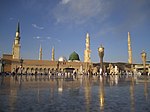Al-Hannanah Mosque
Specifications
The Al-Hannanah Mosque is located in the metropolis of Najaf and Kufah, near the grave of Kumayl ibn Ziyad. It has an area of 7,400 square metres (80,000 sq ft). According to Shaykh Al-Mufid, Sayyed Ibn Tawus and Shahid Awwal, when people arrived at the Al-Hannanah Mosque, they should recite two-unit prayers.
History
Jaafar Mahbouba believes that this mosque was built along with the Imam Ali Shrine. Al-Buraqi believed that this mosque was built by order of Abbas I of Persia, and due to this, he was known amongst the people of Najaf. According to Mohammad Hirz Eddin and Mirza Hadi el-Khurasani, Ghazan ibn Hulagu Khan ordered its construction.
According to a narration of Ja'far al-Sadiq, after Ali ibn Abi Talib died, his sons, Hasan and Husayn, carried his body from Kufa to Najaf. As they were passing, the pillars of the mosque inclined towards the body. The name Al-Hannanah means "to cry twice." This refers to two events: first, when Ali's burial shroud was brought to the Mosque, and second, when the head of his son Husayn was brought through the Mosque.
-
Iwan or entrance of the mosque
See also
References
- ^ Qumi, Abbas (2014). Nafasul Mahmoom. CreateSpace Independent Publishing Platform. ISBN 978-1502504067.
- ^ Staff writer. "The Mosque of the Rass". imamali. Archived from the original on 2016-04-07. Retrieved 2018-01-04.
- ^ Staff writer. "Iraq". Al-Islam.
- ^ Hann, Geoff; Dabrowska, Karen; Townsend-Greaves, Tina (2015). Iraq: The ancient sites & Iraqi Kurdistan. Bradt Travel Guides. ISBN 978-1841624884.
- ^ Majlisi Muhammad Baqir. Bihar al-Anwar. Vol. 97. p. 455.


